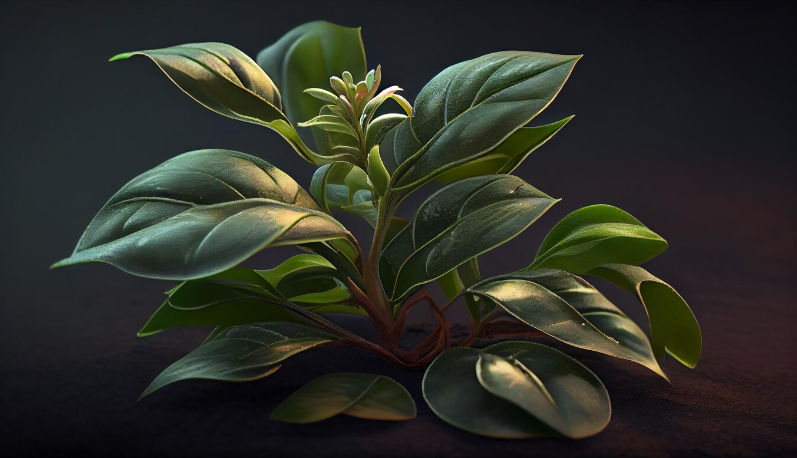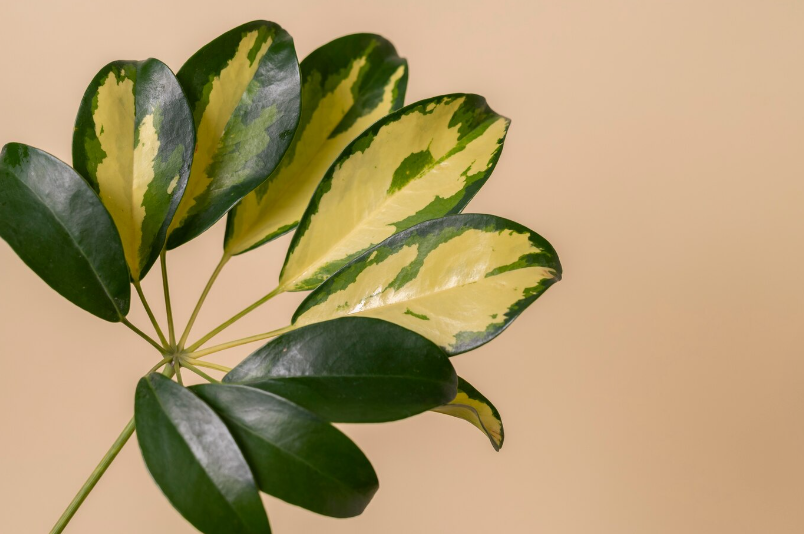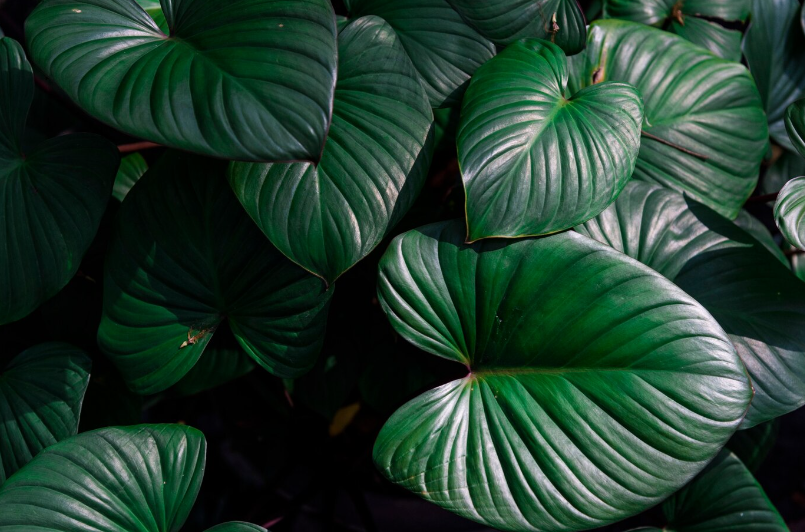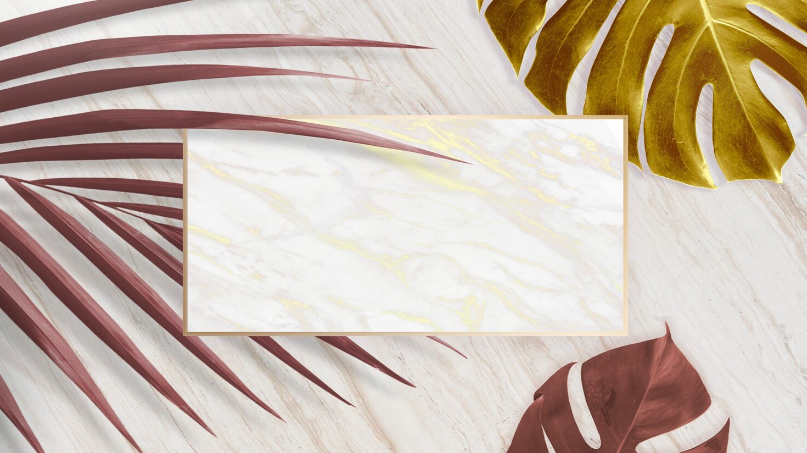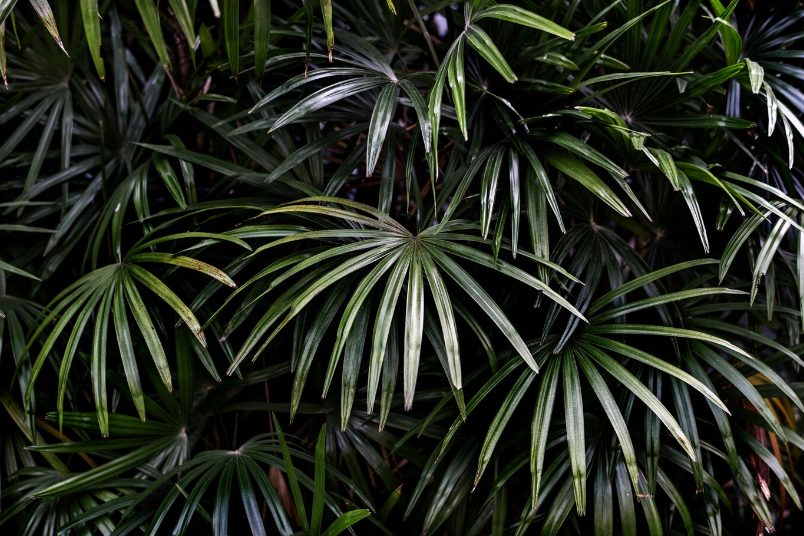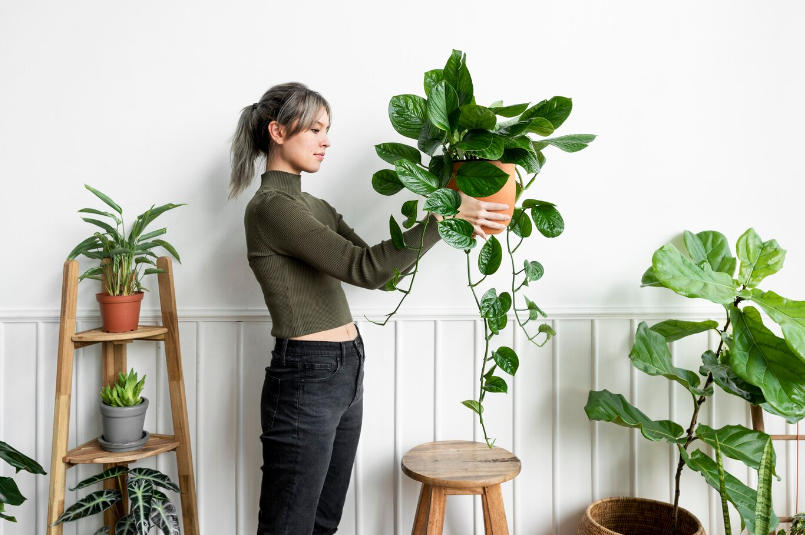Gloriosum and Melanochrysum: The Jewels of the Philodendron World
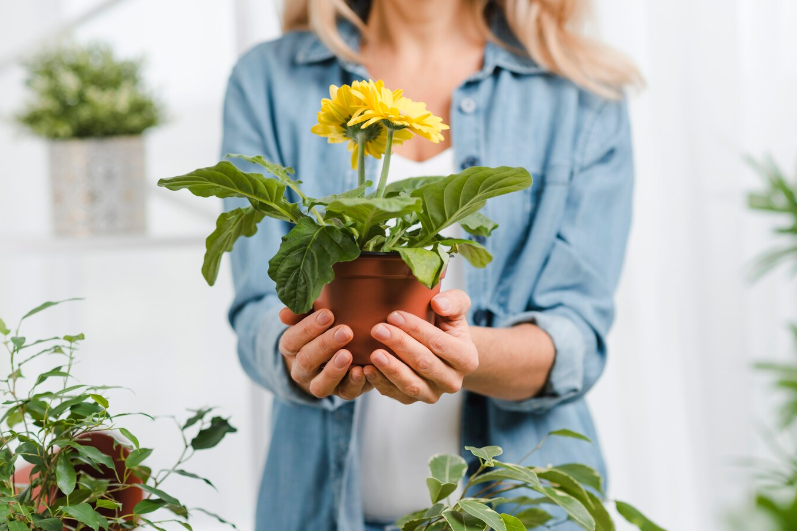
Gloriosum and Melanochrysum – these two magnificent plants are hailed as the crown jewels of the Philodendron world. With their mesmerizing foliage and unparalleled beauty, they are simply irresistible for any plant enthusiast.
The Gloriosum with its lush green leaves adorned with stunning white veins is a sight to behold. It exudes an air of elegance and sophistication, instantly transforming any space into a botanical paradise.
The Melanochrysum is a true showstopper with its velvety, heart-shaped leaves in shades of deep emerald and golden undertones. Its leaves shimmer and glisten in the sunlight, creating a breathtaking display that captivates all who lay eyes on it.
Both the Gloriosum and the Melanochrysum are not just beautiful, they are also known for being relatively easy to care for. They thrive in indoor environments and can adapt to various light conditions, making them perfect for beginners and experienced plant lovers alike.
Whether you’re looking to enhance the aesthetics of your home, office, or any space in between, the Gloriosum and Melanochrysum are sure to elevate any interior with their unique charm and natural allure.
Don’t miss out on the chance to add these exquisite plants to your collection. Order your Gloriosum and Melanochrysum today and experience the unparalleled beauty they bring to your world!
Philodendron Melanochrysum
Native to the rainforests of Southeast Asia, the Melanochrysum is cherished for its velvety, deep green foliage that shimmers and shines as it cascades from its climbing vines. Its leaves can grow to impressive sizes, making it a standout addition to any indoor or outdoor space.
Not only is the Melanochrysum a visual delight, but it also offers a plethora of benefits for plant enthusiasts. Its large leaves are excellent at purifying the air, removing toxins and releasing oxygen, creating a healthier and more breathable environment.
Caring for the Melanochrysum is a breeze, as it thrives in bright, indirect light and enjoys a moist, well-draining soil. Regular watering and misting will keep this beauty happy and thriving.
Whether you are a seasoned plant enthusiast or just starting your collection, the Philodendron Melanochrysum is an absolute must-have. Its enchanting beauty and easy care make it a perfect addition to any home, office, or botanical garden.
Don’t miss your chance to own this exquisite species of Philodendron. Order your very own Melanochrysum today and let it grace your space with its incomparable elegance and charm.
The Difference Between Melanochrysum and Gloriosum
Melanochrysum and Gloriosum are two extraordinary plants from the Philodendron family that are truly the jewels of any plant collection. While both of these plants share some similarities, they also have distinct characteristics that set them apart.
Melanochrysum is known for its stunning velvety leaves that have a rich dark green color. The leaves are often heart-shaped and can grow quite large, making it a statement plant in any room. The texture of the leaves is soft and smooth, which adds to its overall elegance. Melanochrysum is a slow grower but rewards its owners with beautifully shaped leaves that can develop fenestrations as it matures.
Gloriosum, on the other hand, is recognized for its large, heart-shaped leaves that have a vibrant green color and prominent white veins. Unlike Melanochrysum, Gloriosum has a textured and fuzzy appearance, making it visually striking and unique. This variety also grows at a relatively fast pace, allowing plant enthusiasts to enjoy its beauty sooner. With its velvety texture and striking pattern, Gloriosum truly lives up to its name.
Both Melanochrysum and Gloriosum are tropical plants that require similar care. They thrive in bright, indirect light and prefer a well-draining soil mix that retains humidity. Regular watering is necessary to ensure their growth and health. These plants are also known to be relatively easy to propagate, allowing plant lovers to expand their collection and share the beauty of these jewels with others.
In conclusion, while Melanochrysum and Gloriosum both belong to the Philodendron family and share a similar elegance, their unique characteristics make them stand out. Melanochrysum with its dark green, velvety leaves, and slow growth is a perfect choice for those who appreciate a more sophisticated touch. On the other hand, Gloriosum with its vibrant green leaves, prominent white veins, and textured appearance is perfect for those who seek a visually striking and fast-growing addition to their plant collection. No matter which one you choose, you can be sure that these plants will bring a touch of beauty and luxury to any space.
Care and Challenges of Growing Melanochrysum
Growing a Melanochrysum can be a rewarding experience for any plant enthusiast. However, it is important to be aware of the care requirements and potential challenges that come with cultivating this unique species.
One of the key aspects of caring for a Melanochrysum is providing the right conditions. This plant thrives in warm and humid environments, similar to its natural habitat in the tropical rainforests of Southeast Asia. It is best to keep the temperature between 65°F – 80°F (18°C – 27°C) and provide high humidity levels, ideally above 60%. You can achieve this by placing the plant in a bathroom or using a humidifier.
When it comes to watering, Melanochrysum prefers to be kept evenly moist. It is recommended to water the plant thoroughly when the top inch of soil feels dry. However, be cautious not to overwater as it can lead to root rot. Using well-draining soil and a pot with drainage holes can help prevent waterlogged conditions.
Another important aspect of caring for Melanochrysum is providing adequate light. While it prefers bright, indirect light, direct sunlight should be avoided as it can burn the leaves. Optimal locations for this plant are near a north or east-facing window where it can receive bright but filtered light throughout the day.
Fertilizing Melanochrysum is crucial to promote healthy growth. It is recommended to use a balanced, water-soluble fertilizer formulated for houseplants. During the growing season (spring and summer), feed the plant every two weeks. However, reduce fertilization during the dormant period in winter.
Despite its beauty, growing Melanochrysum may come with some challenges. One common issue is the susceptibility to pests such as spider mites and mealybugs. Regularly inspect the plant for any signs of infestation and treat them promptly using an appropriate insecticide or by wiping the leaves with a mild soap solution.
In conclusion, with proper care and attention, Melanochrysum can be a stunning addition to any indoor plant collection. By providing the right conditions, watering adequately, ensuring proper lighting, and handling potential challenges, you can enjoy the beauty and elegance of this unique Philodendron species.
| Care Tips at a Glance | Challenges |
|---|---|
| – Keep temperature between 65°F – 80°F (18°C – 27°C). | – Susceptible to pests like spider mites and mealybugs. |
| – Maintain high humidity levels (above 60%). | – Avoid overwatering to prevent root rot. |
| – Provide bright, indirect light. | – Requires regular fertilization during the growing season. |
| – Water thoroughly when the top inch of soil feels dry. | – Direct sunlight can burn the leaves. |
Unique Traits and Rarity of Melanochrysum
The Melanochrysum is truly a unique and prized member of the Philodendron family. Its distinct characteristics and rarity make it an enticing addition to any indoor jungle or plant collection.
One of the most striking traits of the Melanochrysum is its velvety, heart-shaped leaves. Unlike many other Philodendron varieties, the Melanochrysum’s leaves are covered in a plush, dark green velvet-like texture. This velvety appearance adds a touch of elegance and luxury to any space.
Furthermore, the Melanochrysum is known for its stunning variegated foliage. The leaves are adorned with vibrant splashes of golden-yellow and burnt-orange, creating a mesmerizing display of colors. Each leaf is a work of art, and no two plants are alike, making every Melanochrysum truly special and unique.
Another key characteristic of the Melanochrysum is its relatively slow growth. This slow growth rate contributes to its rarity, as it takes time and patience to cultivate these magnificent plants. Each new leaf that unfurls is a moment to be cherished, making the Melanochrysum a truly rewarding plant to care for and watch flourish.
Due to its rarity and high demand, acquiring a Melanochrysum can be quite a challenge. These plants are often difficult to find in nurseries or online stores. Their limited availability adds to their allure and makes them highly coveted among plant enthusiasts and collectors.
In conclusion, the Melanochrysum stands out among other Philodendron varieties due to its unique traits and rarity. Its velvety leaves, variegated foliage, slow growth, and limited availability make it a true gem in the world of plants. If you are fortunate enough to own a Melanochrysum, you possess a truly extraordinary and prized philodendron.
Discovering Philodendron Gloriosum
Philodendron Gloriosum is a stunning variety of the Philodendron plant family. With its large heart-shaped leaves and contrasting veins, it truly is a jewel that adds elegance to any space. Native to the rainforests of Central and South America, this plant thrives in warm and humid environments.
One of the unique features of Philodendron Gloriosum is its velvety texture. The leaves have a soft, velvety feel when touched, making it a delight to interact with. This texture, combined with its vibrant green color, makes it a visually striking plant.
Philodendron Gloriosum is a low-maintenance plant, making it an ideal choice for both experienced plant enthusiasts and beginners. It prefers bright, indirect light and well-draining soil. Regular watering and occasional misting will keep this plant happy and healthy.
Adding a Philodendron Gloriosum to your indoor garden will not only bring beauty but also provide several health benefits. Like other plants, it helps purify the air by absorbing toxins and releasing oxygen. Additionally, it contributes to a calming and relaxing atmosphere, making it a perfect choice for any living or workspace.
Whether you are a seasoned plant collector or just starting your journey, Philodendron Gloriosum is a must-have in your collection. Its unique beauty and easy care make it a jewel that will continue to shine for years to come.
What Philodendron is Similar to Gloriosum?
- Velvety Leaves: Just like Gloriosum, Melanochrysum boasts large, heart-shaped leaves that are covered in a velvety texture. Running your fingers over these luxurious leaves is an irresistible sensory experience.
- Rich Green Color: The lush green color of Melanochrysum leaves is similar to that of Gloriosum. It adds a touch of elegance and sophistication to any space, making it a popular choice among plant enthusiasts.
- Size and Growth: Like Gloriosum, Melanochrysum is a relatively large Philodendron variety. It can grow to impressive sizes, making it a statement piece in any room or garden.
- Philodendron Family: Gloriosum and Melanochrysum both belong to the Philodendron genus, which is known for its beautiful foliage and easy care requirements.
- Tropical Vibe: Both Gloriosum and Melanochrysum have a tropical vibe that instantly transports you to lush rainforests. They are perfect choices if you want to create a jungle-like atmosphere in your indoor or outdoor space.
So, if you adore Gloriosum, make sure to explore the captivating world of Philodendron Melanochrysum. Its velvety leaves, rich green color, impressive size, and tropical vibe make it a perfect choice for any plant lover.
Growth Habits: Gloriosum as a Crawler or Climber
The Gloriosum philodendron is known for its versatile growth habits, allowing it to adapt to a variety of environments. One of its most remarkable characteristics is its ability to crawl or climb, making it a unique addition to any plant collection.
As a crawler, the Gloriosum philodendron will spread its lush, heart-shaped leaves along the ground, creating a beautiful carpet of greenery. This growth habit is perfect for filling empty spaces in a garden or adding visual interest to indoor plant arrangements.
Alternatively, the Gloriosum philodendron can be trained to climb, using its aerial roots and long, vining stems. With the help of a trellis or support structure, this philodendron will reach new heights, showcasing its stunning foliage and creating an eye-catching display.
Whether you choose to let it crawl or encourage it to climb, the Gloriosum philodendron will thrive in bright, indirect light and well-draining soil. Regular watering and occasional misting will help maintain its health and vigor.
With its unique growth habits and striking appearance, the Gloriosum philodendron is truly a jewel in the world of philodendrons. Add this extraordinary plant to your collection today and watch it flourish in your home or garden.
Rarity and Appeal of Philodendron Gloriosum
The Philodendron Gloriosum is one of the most sought-after plants in the world of tropical plants. With its stunning beauty, unique foliage, and distinct characteristics, it has captured the hearts of plant enthusiasts and collectors everywhere.
One of the most notable features of the Philodendron Gloriosum is its large, heart-shaped leaves that display a velvety texture. The leaves have a rich green color that contrasts beautifully with the white veins running through them, creating an eye-catching pattern that is truly mesmerizing.
What makes the Philodendron Gloriosum even more special is its rarity. It is native to the rainforests of South America and is not commonly found in cultivation. This adds to its allure and makes it a prized possession for plant lovers who value the unique and hard-to-find.
In addition to its visual appeal and scarcity, the Philodendron Gloriosum also has its practical benefits. It is known for its air-purifying qualities, helping to improve the quality of indoor air by removing toxins and adding oxygen.
Caring for the Philodendron Gloriosum may require a little extra attention, but the rewards are well worth it. It prefers bright, indirect light and well-draining soil. Regular watering and moderate humidity levels will help keep this plant happy and thriving.
- Origin: South America
- Light: Bright, indirect light
- Watering: Regular watering, allowing the soil to dry out between waterings
- Humidity: Moderate humidity levels
- Size: Can reach a height of 3-4 feet
If you’re looking to add a touch of elegance and rarity to your indoor plant collection, the Philodendron Gloriosum is the perfect choice. Its unique foliage, scarcity, and air-purifying qualities make it a truly captivating addition to any space.
Cultivation and Care Techniques
Proper cultivation and care techniques are essential to ensure the healthy growth and beauty of Gloriosum and Melanochrysum, the jewels of the Philodendron world.
Light: Gloriosum and Melanochrysum thrive in bright, indirect light. Avoid exposing them to direct sunlight, as it can scorch their delicate leaves. Place them near a window with filtered or dappled sunlight for optimal growth.
Temperature: These plants prefer warm temperatures between 65-85°F (18-29°C). Protect them from drafts and extreme temperature fluctuations, which can stress the plants.
Humidity: Gloriosum and Melanochrysum are tropical plants that love high humidity levels. Mist them regularly or keep them in a humid environment, such as a bathroom or a pebble tray filled with water.
Watering: It is important to keep the soil consistently moist but not waterlogged. Allow the top inch of soil to dry out before watering again. Overwatering can lead to root rot, while underwatering can cause the leaves to wilt and turn brown.
Soil: These Philodendrons prefer a well-draining and aerated potting mix. A mix of peat moss, perlite, and orchid bark provides the ideal growing medium. Avoid compacted and heavy soils that retain too much moisture.
Fertilizer: Feed Gloriosum and Melanochrysum with a balanced, water-soluble fertilizer every 4-6 weeks during the growing season (spring and summer). Follow the package instructions for the proper dosage and avoid overfertilization, as it can burn the plant’s roots.
Propagation: These plants can be propagated through stem cuttings. Take a healthy stem cutting with at least two leaves and place it in a jar of water until roots develop. Then, transfer the cutting into a pot with the appropriate potting mix.
Pests: Keep an eye out for common houseplant pests such as aphids, mealybugs, and spider mites. Regularly inspect the plant and treat any infestation promptly with an appropriate insecticidal soap or neem oil.
Pruning: Prune Gloriosum and Melanochrysum to maintain their shape and remove any dead or yellowing leaves. Use clean and sharp pruning tools to avoid introducing diseases to the plant.
Overall, Gloriosum and Melanochrysum are stunning additions to any indoor plant collection. With the right cultivation and care techniques, you can enjoy their lush foliage and vibrant colors for years to come.
Is Philodendron Melanochrysum Easy to Grow?
If you are a plant enthusiast, you may have come across the stunning Philodendron Melanochrysum. Known for its large heart-shaped leaves and velvety texture, this plant has become a sought-after jewel in the world of Philodendrons. But is it easy to grow?
The good news is that Philodendron Melanochrysum is relatively easy to care for, making it a great choice for both beginner and experienced plant lovers. With the right conditions, this plant can thrive and bring beauty to any space.
To ensure the best growth for your Philodendron Melanochrysum, here are a few key factors to consider:
- Light: Philodendron Melanochrysum prefers bright, indirect light. Place it near a window where it can receive filtered sunlight, but avoid direct exposure to harsh rays.
- Temperature: This plant thrives in warm temperatures between 65°F to 85°F (18°C to 29°C). Avoid exposing it to extreme cold or hot drafts.
- Humidity: Philodendron Melanochrysum loves humidity. Mist the leaves regularly or place a humidifier nearby to create a humid environment. You can also group it with other plants to increase moisture levels.
- Watering: Keep the soil evenly moist, but not soggy. Water the plant when the top inch of soil feels slightly dry. Overwatering can lead to root rot, so ensure proper drainage.
- Fertilization: Feed your Philodendron Melanochrysum with a balanced, water-soluble fertilizer during the growing season (spring and summer) to promote healthy foliage.
- Pruning: Remove any yellow or decaying leaves to maintain the plant’s overall health and appearance. You can also trim leggy stems to encourage bushier growth.
By following these care tips, you can create the perfect conditions for your Philodendron Melanochrysum to thrive. Whether you are a seasoned plant parent or just starting your collection, this gorgeous plant will surely be a showstopper in your home or garden.
Techniques for Encouraging Large Leaves in Melanochrysum
Melanochrysum, also known as “The Jewel of the Philodendron World,” is a stunning plant with its unique massive leaves. If you want to encourage the growth of large leaves in your Melanochrysum, there are several techniques that you can try:
| Technique | Description |
|---|---|
| Provide Ample Light | Melanochrysum thrives in bright, indirect light. Place your plant near a window where it can receive plenty of natural light, but avoid direct sunlight, as it can scorch the leaves. Alternatively, you can use grow lights to supplement the natural light. |
| Maintain Optimal Temperature and Humidity | Melanochrysum prefers warm and humid environments. Ensure that the temperature stays between 65-80°F (18-27°C) and the humidity levels are around 60-70%. You can use a humidifier or place the plant on a tray filled with water and pebbles to increase humidity. |
| Provide Adequate Watering | Keep the soil evenly moist, but not soggy. Melanochrysum prefers well-draining soil, so make sure the pot has drainage holes to prevent waterlogged roots. Check the moisture levels regularly and adjust your watering schedule accordingly. |
| Fertilize Regularly | Feed your Melanochrysum with a balanced liquid fertilizer every 4-6 weeks during the growing season (spring and summer). This will provide the necessary nutrients for leaf development. Follow the dosage instructions on the fertilizer package. |
| Ensure Adequate Airflow | Adequate airflow around the plant is essential for preventing diseases and promoting healthy leaf growth. Avoid placing your Melanochrysum in a stagnant or drafty area. Gentle air circulation can be beneficial. |
By following these techniques, you can encourage your Melanochrysum to produce larger leaves, enhancing its beauty and making it a true gem in your indoor plant collection.
Humidity and Moss Pole Requirements for Melanochrysum
As a tropical plant, Melanochrysum requires high humidity levels to thrive. It is crucial to provide the plant with a humid environment to mimic its natural habitat. Proper humidity ensures that the plant’s leaves retain their beautiful velvety texture and vibrant color.
To maintain the ideal humidity level for Melanochrysum, consider the following tips:
1. Mist the leaves: Regularly misting the leaves with water is an effective way to increase humidity around the plant. Use a spray bottle filled with filtered or distilled water and mist the leaves every few days, especially during drier seasons.
2. Use a humidity tray: Placing the Melanochrysum pot on a tray filled with water and pebbles can create a small microclimate of increased humidity. As the water evaporates, it creates moisture around the plant, keeping it hydrated.
3. Group plants together: Grouping Melanochrysum with other tropical plants can create a humid microclimate. The plants release moisture through transpiration, increasing the humidity levels for all the plants in the vicinity.
4. Employ a humidifier: Using a humidifier near the Melanochrysum can help maintain a consistent level of humidity. Set the humidifier to a level of 50-60% for optimum growth and health of the plant.
In addition to humidity, Melanochrysum benefits from the support of a moss pole. As this plant grows, it develops long aerial roots which seek support in its natural habitat. Providing a moss pole ensures that the plant has a sturdy structure to attach and grow on.
Here are some key points to consider when using a moss pole for Melanochrysum:
1. Choose a suitable moss pole: Select a moss pole that is tall enough to accommodate the plant’s growth. The pole should be made of natural materials, such as sphagnum moss or coir, to provide optimal support and moisture retention.
2. Secure the moss pole: Gently attach the Melanochrysum stems to the moss pole using plant ties or soft twine. Avoid using materials that may damage the plant or restrict its growth.
3. Water the moss pole: Keep the moss pole moist by watering it regularly. This will not only provide necessary moisture to the plant but also encourage the growth of beneficial moss and help maintain humidity levels.
By ensuring proper humidity levels and providing a moss pole for support, you can help your Melanochrysum thrive and become a stunning jewel in your philodendron collection. Remember to regularly monitor the plant’s humidity requirements and adjust accordingly to promote its growth and well-being.
Comparisons and Curiosities
When it comes to exceptional Philodendron plants, Gloriosum and Melanochrysum are truly the jewels of the Philodendron world. But what sets them apart? Let’s explore some comparisons and curiosities:
- Size: Gloriosum and Melanochrysum both belong to the large-sized Philodendron family. Gloriosum can reach heights of up to 3 feet, while Melanochrysum can grow even taller, up to 5 feet.
- Leaf color: Gloriosum is known for its lush, dark green leaves that have a velvety texture and prominent white veins. On the other hand, Melanochrysum boasts stunning, heart-shaped leaves that start off as dark green and develop into a beautiful golden color.
- Leaf size: While both plants have large leaves, Gloriosum’s leaves are slightly smaller compared to Melanochrysum. Gloriosum leaves typically measure around 8-12 inches in length, while Melanochrysum leaves can reach up to 14 inches or more.
- Growth rate: Gloriosum is known for its relatively fast growth rate, whereas Melanochrysum is considered to be a slower grower. This makes Gloriosum a popular choice for those looking to quickly fill up a space with lush foliage.
- Availability: Gloriosum and Melanochrysum are both highly sought-after plants among Philodendron enthusiasts. However, due to their popularity and limited availability, they can be quite difficult to find and may come with a higher price tag.
Whether you choose Gloriosum or Melanochrysum, both of these Philodendron plants will undoubtedly bring a touch of elegance and beauty to any indoor space. Their unique characteristics and vibrant foliage make them prized possessions for any plant lover.
The Rarest and Most Beautiful Philodendron Varieties
When it comes to Philodendron plants, Gloriosum and Melanochrysum are the true jewels of the Philodendron world. These rare and highly sought-after varieties are known for their breathtaking beauty and unique characteristics.
The Gloriosum Philodendron is renowned for its velvety, heart-shaped leaves that feature stunning hues of dark green and silver. Its leaves have a distinctly regal appearance, making it a true standout in any collection. The velvety texture of the leaves adds to its allure, making it a pleasure to touch and behold.
On the other hand, the Melanochrysum Philodendron is famous for its large, glossy leaves that showcase a mesmerizing combination of deep green and vibrant yellow. The contrasting colors create a striking visual appeal that is hard to resist. Its leaves are big and showy, giving it a bold and vibrant presence.
Both the Gloriosum and Melanochrysum Philodendron varieties are not only visually stunning but also relatively rare. Their scarcity adds to their allure and makes them highly sought-after by plant enthusiasts and collectors around the world.
Adding Gloriosum and Melanochrysum Philodendron plants to your collection is like owning a piece of natural art. These exquisite and rare varieties will undoubtedly become the centerpiece of any space, be it a living room, garden, or office.
If you are looking to enhance your collection with the most beautiful and rare Philodendron varieties, Gloriosum and Melanochrysum are definitely the ones to consider. Their unmatched beauty and scarcity make them a valuable addition to any plant lover’s repertoire.
So why wait? Get your hands on these jewels of the Philodendron world today and experience the magic they bring to your botanical haven.
Comparing Melanochrysum with Other Philodendrons
Melanochrysum is a truly unique and stunning variety of philodendron, known for its distinctive features and incredible beauty. In this section, we will compare Melanochrysum with other popular philodendrons, highlighting why it stands out from the crowd.
1. Gloriosum
Gloriosum is another highly sought-after philodendron variety, known for its large heart-shaped leaves and beautiful velvety texture. While Gloriosum and Melanochrysum share similarities in their leaf shape and texture, Melanochrysum stands out with its vibrant golden coloration and unique pattern of prominent dark veins.
2. Birkin
Birkin is a relatively new philodendron variety, known for its white pinstripes on dark green leaves. While Birkin has its own charm with its contrasting coloration, Melanochrysum outshines it with its larger size, vibrant golden color, and distinctive leaf pattern.
3. Pink Princess
Pink Princess is a highly popular philodendron variety, loved for its stunning pink variegation on dark green leaves. While Pink Princess has its own allure, Melanochrysum surpasses it with its larger size, unique golden color, and striking dark veins.
4. Xanadu
Xanadu is a compact philodendron variety, known for its dense foliage and elegant appearance. While Xanadu is appreciated for its compact size, Melanochrysum stands out with its majestic presence, larger leaves, and its captivating golden coloration that catches everyone’s attention.
In conclusion, Melanochrysum truly stands out from other philodendrons with its vibrant golden color, unique leaf pattern, and enchanting appearance. It is a jewel in the world of philodendrons that will bring a touch of elegance and beauty to any space.
Philodendron Climbing Preferences: Climbing vs. Hanging
Philodendrons are known for their beautiful foliage, which makes them a popular choice among plant enthusiasts. These stunning plants come in many varieties, but when it comes to their growing habits, they can be broadly classified into two categories: climbing and hanging.
1. Climbing Philodendrons:
- Climbing philodendrons are characterized by their ability to climb and attach themselves to surfaces. These plants have specialized aerial roots that allow them to cling onto trees, walls, or any other support structure they find.
- They are natural climbers and thrive when given a moss pole, trellis, or other vertical support to climb on. This allows the plant to grow towards the light and develop their signature vining habit.
- Common climbing varieties include Philodendron gloriosum and Philodendron melanochrysum, which are known for their large, heart-shaped leaves and stunning variegation.
2. Hanging Philodendrons:
- On the other hand, hanging philodendrons have a more cascading growth habit and are better suited for hanging baskets or trailing from shelves.
- These plants do not have specialized climbing structures and prefer to grow in a more relaxed, trailing manner. They are perfect for adding a touch of greenery to high shelves or as beautiful hanging displays.
- Popular hanging varieties include Philodendron hederaceum and Philodendron cordatum, which feature smaller heart-shaped leaves and are well-adapted to indoor environments.
Both climbing and hanging philodendrons require similar care when it comes to watering, lighting, and temperature. However, it’s important to provide the appropriate support structure for climbing philodendrons to allow them to thrive and reach their full potential.
Whether you choose a climbing or hanging philodendron, these plants will surely bring a touch of beauty and elegance to any space. So why not add a touch of nature to your home with these jewels of the philodendron world?
Question-answer:
What is Gloriosum and Melanochrysum The Jewels of the Philodendron World?
Gloriosum and Melanochrysum are two rare varieties of Philodendron plants known for their stunning and unique foliage. They are considered some of the most coveted plants in the Philodendron world.
Where can I buy Gloriosum and Melanochrysum The Jewels of the Philodendron World?
You can buy Gloriosum and Melanochrysum plants from specialized plant nurseries or online stores that specialize in rare and exotic plants. Make sure to do some research and buy from reputable sellers to ensure the quality of the plants.
How do I care for Gloriosum and Melanochrysum plants?
Gloriosum and Melanochrysum plants prefer bright, indirect light. They should be kept in well-draining soil and watered when the top inch of soil is dry. These plants thrive in humid conditions, so misting the leaves or using a humidifier can help maintain the right environment. Additionally, it is important to avoid overwatering and ensure good air circulation around the plants.
Are Gloriosum and Melanochrysum plants easy to grow?
Gloriosum and Melanochrysum plants are considered moderately difficult to grow. They require specific conditions such as bright, indirect light, well-draining soil, and high humidity. However, with proper care and attention to their specific needs, these plants can thrive and reward their owners with their stunning foliage.
Can Gloriosum and Melanochrysum plants be propagated?
Yes, Gloriosum and Melanochrysum plants can be propagated through stem cuttings. Select a healthy stem with at least one leaf node, make a clean cut just below the node, and place the cutting in moist soil or water until roots develop. It may take a few weeks for roots to form, but with patience and proper care, you can successfully propagate these plants.
What is the difference between Gloriosum and Melanochrysum?
Gloriosum and Melanochrysum are both philodendron plants, but they have some differences. Gloriosum has large heart-shaped leaves that are velvety and deep green with white veins. On the other hand, Melanochrysum has glossy, heart-shaped leaves that start off green and gradually turn dark green with reddish undersides as they mature.
How should I care for Gloriosum and Melanochrysum?
Gloriosum and Melanochrysum are tropical plants and require similar care. They thrive in well-draining soil, bright indirect light, and high humidity. It’s important to water them regularly, but not overwater. You can use a humidifier or mist their leaves to increase humidity. Also, make sure to provide support for their climbing vines.
